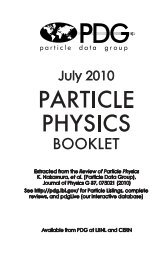30. Passage of particles through matter 1 - Particle Data Group
30. Passage of particles through matter 1 - Particle Data Group
30. Passage of particles through matter 1 - Particle Data Group
Create successful ePaper yourself
Turn your PDF publications into a flip-book with our unique Google optimized e-Paper software.
Cross section (barns/atom)<br />
1 Mb<br />
1 kb<br />
1 b<br />
1 Mb<br />
1 kb<br />
Cross section (barns/atom) 10 mb<br />
1 b<br />
<strong>30.</strong> <strong>Passage</strong> <strong>of</strong> <strong>particles</strong> <strong>through</strong> <strong>matter</strong> 23<br />
σ p.e.<br />
σ Rayleigh<br />
σ p.e.<br />
σ Rayleigh<br />
σ Compton<br />
σ Compton<br />
(a) Carbon (Z = 6)<br />
- experimental σtot (b) Lead (Z = 82)<br />
- experimental σ tot<br />
σ g.d.r.<br />
κnuc κe κ nuc<br />
10 mb<br />
10 eV 1 keV 1 MeV<br />
Photon Energy<br />
1 GeV 100 GeV<br />
Figure <strong>30.</strong>15: Photon total cross sections as a function <strong>of</strong> energy in carbon and<br />
lead, showing the contributions <strong>of</strong> different processes [48]:<br />
σp.e. = Atomic photoelectric effect (electron ejection, photon absorption)<br />
σRayleigh = Rayleigh (coherent) scattering–atom neither ionized nor excited<br />
σCompton = Incoherent scattering (Compton scattering <strong>of</strong>f an electron)<br />
κnuc = Pair production, nuclear field<br />
κe = Pair production, electron field<br />
σg.d.r. = Photonuclear interactions, most notably the Giant Dipole Resonance<br />
[49]. In these interactions, the target nucleus is broken up.<br />
Original figures <strong>through</strong> the courtesy <strong>of</strong> John H. Hubbell (NIST).<br />
June 18, 2012 16:19<br />
κ e







